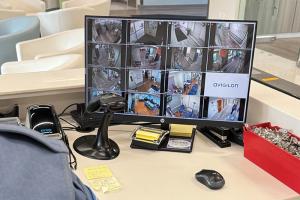Health care systems use data to help avert workplace violence

Bristol Health had to rethink some of its security protocols to better suit the layout of its new emergency department.
Image courtesy of Bristol Health
Quantitative data tells a clear story that health care workplace violence is a growing problem. However, health systems are finding that qualitative data, supported by staff interviews, is equally important in helping health systems drive improvements in their violence mitigation strategies.
The value of qualitative data was recently illustrated by researchers at the Yale School of Medicine, who published a study called “The Aggressive Incidents in Medical Settings (AIMS) Study: Advancing Measurement to Promote Prevention of Workplace Violence” in The Joint Commission’s Journal on Quality and Patient Safety in November 2023. The researchers say more precisely measuring nurses’ and patient care assistants’ rates of exposure to patient aggression within inpatient medical units could deliver better insights into workplace violence mitigation and intervention strategies.
Study participants were asked to document incidents, their severity and how these incidents impacted their ability to care for patients in aggressive incident and management logs (AIM-Logs). The researchers concluded that the combination of quantitative data and use of AIM-Logs as debriefing tools helped leaders more effectively justify the need for violence mitigation actions, such as adding resources to help staff.
In the case of New York City-based NewYork-Presbyterian (NYP), data helps set the stage for use of de-escalation techniques. The 11-hospital system uses a formalized violence risk assessment tool to flag patients in its electronic medical record system who have violent histories. This early warning system enables providers to proactively prepare teams equipped to manage patients who may become violent.
This use of data is part of a broader risk assessment effort that brings together staff from the security department, emergency management team, legal and compliance teams, investigations, human resources, patient experience team, clinicians and others. NYP has also invested in information technology infrastructure to help it better evaluate its workplace violence prevention efforts and outcomes.
Bristol Health, an integrated health system based in Bristol, Conn., has adopted a similar approach. The system uses data gathered through its incident reporting system to direct security rounds focused on collecting feedback from staff about these incidents. Alongside security-focused town halls, this data-and-feedback approach has helped identify gaps in security coverage, strengthened collaboration with the local police department and expanded the system’s ability to access grants and other funding opportunities.
Among other issues, data pointed the security team to investigate response challenges in its new emergency room (ER). The new space was more spread out than the previous ER, leaving staff isolated when confronted with the threat of violence.
Data helped identify the need to make it easier for staff to call for help, prompting adoption of wearable duress alarms. Moreover, interviews with ER staff revealed that patient access representatives were not equipped with de-escalation training.
Kurt Barwis, Bristol Health president and CEO, says these discussions helped leadership “to think beyond the bedside caregivers to everyone who is coming into contact with people, where they are coming in contact with them and how to give them a tool set they can use to effectively de-escalate a situation.”
Through town hall meetings, Bristol Health leadership learned that incidents in the behavioral health unit prompted a response from all security staff, leaving the ER uncovered. As a result of this feedback, the hospital shifted to a tiered response based on the level of threat.
“One of the key takeaways was that every six months we have to review the [staffing] resources we’re applying and the resources we might be missing,” Barwis says.
This multipronged information-gathering approach has helped leaders identify security needs — but having strong data to support these findings also helped make a strong case in grant applications. As a result, the hospital has been successful in receiving city funding for many of its security improvements




